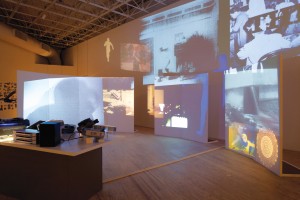« Reviews
Stan VanDerBeek: The Culture Intercom
Contemporary Art Museum - Houston
Curated by Bill Arning and Joao Ribas
“Only a country that feels invulnerable can afford political turmoil as entertainment.”
-Lionel Shriver
By Garland Fielder
The culture of infotainment that currently reigns supreme in America has tentacles reaching far into the past. The yellow journalism that passes for news spewed forth nightly on cable channels has precedence in the newspaper business since newspapers have existed. It is the relative ease with which memes surface and sustain for their short duration that only seems new. While we have countless new gadgets upon which we can access the flow of information, the flow itself is really nothing new. Stan VanDerBeek knew a thing or two about the flow. In his retrospective, “The Culture of Intercom,” on view at the CAMH through July 10th, it is also evident that his grasp of the multitude of media, or at least his bold approach to experimentation with burgeoning technologies of the 50s and early 60s, was extensive. VanDerBeek’s experimental cinematic work is his most celebrated, but only part of his overall vision, which was about discovering the relationship between modern man and his technologies and celebrating the creative and substantive changes possible.

Stan VanDerBeek, Movie Mural, 1968/2011. Approximate restaging of VanDerBeek’s multimedia installation Movie Mural (1968) at the Contemporary Arts Museum Houston in 2011, dimensions variable. Courtesy The Estate of Stan VanDerBeek. Photo: Rick Gardner.
In this way, much of the show contains preparatory materials that give insight into the artist’s thoughts and strategies. These are often collages used for animation sequences or pages from sketchbooks detailing various schematics of VanDerBeek’s more ambitious projects. They are informal and refreshing to see, adding a softer tone to what at times could become didactic. Much of VanDerBeek’s work is political-jarring images of the Vietnam conflict with absurdist collages channeling Dada and looking remarkably like Terry Gilliam’s animation from Monty Python, which must have been a significant influence. In a two-channel video piece, Violence Sonata, 1970, VanDerBeek plays with images of import concerning the nuclear age as well as America’s cultural turmoil from the period mashed up with a narrative that comments on education, race, and other dystopic ingredients of the roiling cultural revolution of the late 60s. This video is presented as a sort of schizophrenic stereoscopic image of the times.
In the most explosive and visually dissonant work of the show, Movie Mural, 1968, a visual assault, is displayed on a large part of the wall and scrawls across the ceiling. It consists of a “collage of media” that similarly comments on popular culture. Some images are still, others frantic, expending the viewer’s attention. In another project, the Movie Drome, from 1963-65, VanDerBeek built a media planetarium to display a roiling mix of video and cinema projected onto the interior of the space-a sort of fandango experience meant to concentrate the viewing group’s creative unconsciousness. Indeed, all of VanDerBeek’s work can be described as groovy-there is definitely a hippy vibe infused throughout his oeuvre. As a result, some works feel dated and redundant, but over all, it is nice to see such a wide scoping array of art from a man who really believed in the transformative nature of technology in society. It is easy to be cynical about this position today, but one cannot help but admire the pioneering spirit VanDerBeek held on to throughout his career.
(May 14 - July 10, 2011)
Garland Fielder is an artist and writer based in Houston.
Filed Under: Reviews


































